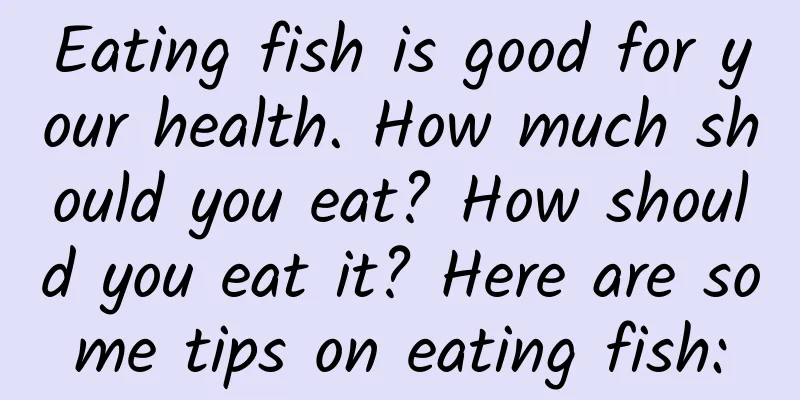Eating fish is good for your health. How much should you eat? How should you eat it? Here are some tips on eating fish:

|
Eating fish regularly is good for your health, which is health advice that many people have heard. However, what kind of fish to eat? How much fish to eat? How to eat fish? Many people are confused. Especially for children, expectant mothers and breastfeeding mothers, what should they pay attention to? On November 12, 2021, the U.S. FDA (Food and Drug Administration) and EPA (U.S. Environmental Protection Agency) issued "Fish Eating Recommendations". Taking this opportunity, let's talk about these things today. The FDA and EPA's recommendations are mainly to provide guidance on how to eat fish healthily for pregnant women, breastfeeding women, and children aged 1 to 11. However, this "fish eating recommendation" is consistent with the recommendations in the 2020 edition of the "Dietary Guidelines for Americans" and the Dietary Guidelines for Chinese Residents. In short, these recommendations also apply to people of other ages. We have combined the latest recommendations from the United States, the recommendations from China's dietary guidelines, and information from other research materials at home and abroad to sort out various issues related to healthy fish eating. Let's take a look at the answers below! 1 What are the benefits of eating fish? For infants and young children, the nutrients contained in fish help the development of the nervous system. Fish is part of a healthy diet and should be eaten regularly from an early age. Whether during pregnancy, breastfeeding or infancy, eating fish can provide important nutrients for the brain development of the fetus and infant, especially omega-3 fatty acids (including DHA and EPA). Fish also contains important nutrients such as iron, zinc, iodine, and choline. The iodine requirement during pregnancy and lactation is about twice that before pregnancy. Adequate iodine is very important for the intellectual development of the fetus and infant, so most expectant mothers and new mothers need to consume seafood appropriately and insist on eating iodized salt. Iron and zinc support the immune system of children and are also important components of the hematopoietic system. Choline, which may not be familiar to everyone, can promote the development of the baby's spinal cord. Other studies have found that consuming more choline during the fetal period can help reduce the baby's stress response after birth. In addition, fish is also rich in many other nutrients, such as high-quality protein, vitamin B12, vitamin A, vitamin D, and selenium. Among them, vitamin A and vitamin D are more likely to be deficient in Chinese people. It is recommended that pregnant women eat fish during pregnancy because studies have shown that eating fish is beneficial to the development of the fetus's cognitive function. For adults, eating fish has several health benefits, too. There is a lot of research evidence that a healthy diet that regularly eats fish has health benefits for adults, including: Helps prevent cardiovascular and cerebrovascular diseases Promotes bone health and reduces the risk of hip fractures Reduce the risk of overweight and obesity Reduces the risk of colon and rectal cancer The so-called "healthy diet pattern containing fish" requires not only eating fish regularly, but also consuming sufficient fresh vegetables, fruits, beans, and whole grains, as well as eating low-fat or skim milk, lean meat and poultry, nuts, and vegetable oils rich in unsaturated fatty acids in moderation. At the same time, the amount of red meat and processed meat should be reduced, and the amount of sweets, sweet drinks, and refined grains should be controlled. 2 Be careful to choose safe fish. Which ones are safer? Although fish and other aquatic products are good for health, they are also a type of food that easily causes environmental pollution. Fish is what I like, but pollution is what I don’t like. Studies have found that eating fish is good for the intellectual development of infants and young children, but if the intake of mercury is too high, it will reduce the intelligence level. The "Fish Eating Recommendations" released this time reminds people to choose fish with low mercury content. It is especially important for pregnant women, breastfeeding women and children to reduce their dietary mercury intake. Mercury is a common environmental pollutant that exists in rivers, lakes and oceans. It is easily converted into methylmercury, which gradually accumulates and concentrates to become a major pollutant in fish and aquatic products. After mercury enters the human body, it is excreted very slowly. Long-term exposure to excessive methylmercury can cause cumulative poisoning and damage the brain and nervous system. Almost all fish contain trace amounts of methylmercury, but the amounts vary greatly. Large carnivorous fish are more likely to accumulate methylmercury. For the same fish, the longer they live, the more mercury they accumulate. The same fish will experience a higher degree of pollution if it lives in heavily polluted waters. Methylmercury in fish cannot be removed by washing, nor can it be broken down by heating or cooking. The main way to reduce mercury intake is to choose safe fish species. The FDA's database of commercial fish and other sources collects information on the mercury content of each type of fish. After careful evaluation, the experts who published the "Fish Eating Guide" calculated the safe weekly fish servings for pregnant women. According to the safe intake of mercury, If a fish is eaten at least three times a week, it is included in the "best choice" category; If a particular fish can only be eaten 1-2 times a week, it is classified as a "good choice." If a particular fish cannot be eaten more than once a week, put it in the "avoid" category. Now let’s take a look at what fish we can choose. Best Choice Anchovies, Atlantic yellow croaker, Atlantic mackerel (mackerel), black sea bass, butterfish, ocean catfish, clams, cod, crab, freshwater lobster, flatfish, haddock, sturgeon, herring, American lobster, mullet, oysters, North Atlantic mackerel (mackerel), freshwater bass, pike, plaice, haddock, salmon, sardines, scallops, herring, prawns, skate, smelt, snapper, squid, tilapia, trout (freshwater), tuna (canned tuna), whitefish, hake (small hake) Good choice Horse mackerel, buffalo fish, carp, Chilean sea bass/Antarctic toothfish, grouper, halibut, mahi-mahi, monkfish, rockfish, sablefish, red bass (sheepshead), snapper, Spanish mackerel (mackerel), striped bass (saltwater), tilefish (Atlantic), tuna (albacore/white tuna, canned, fresh, frozen), tuna (yellowfin), sea trout (coratos), white mullet Avoid Selection Atlantic mackerel, marlin (sailfish), orange roughy, shark, swordfish, tilefish (Gulf of Mexico), tuna (bigeye) According to the table and the data from my country, the aquatic products that Chinese people eat the most, such as hairtail, yellow croaker, flounder, river perch, tilapia, sturgeon, cod, salmon, sardines, prawns, scallops, squid, shrimp and crabs, are relatively safe. Sea bass, mackerel, grouper, snapper and halibut are also within the "good choice" range of 1 to 2 times a week. 3 How much fish should you eat per week? It is recommended to eat 2-3 servings of fish per week. The amount of "1 serving" varies depending on age: 1~3 years old, 1 ounce, about 30 grams 4~7 years old, 2 ounces, about 60 grams 8~10 years old, 3 ounces, about 90 grams 11 years and older, 4 ounces (about 120 grams) Pregnant and breastfeeding women, 4 ounces, about 120 grams. If you find it a bit troublesome to eat according to the quantity, you can use your palm to help. The bigger the person, the more they need to eat, so don't worry about the different sizes of everyone's palms. The size of your palm determines the size of the piece of fish that is your "portion". It is best to choose 2 to 3 servings of fish from the "Best Choices" list, or you can choose 1 serving from the "Best Choices" list and 1 serving from the "Good Choices" list. 4 Can pregnant women and children eat raw fish and shrimp? It is not recommended for pregnant women and children to eat raw fish and seafood, including sushi and sashimi. Pregnant women and children have weaker immune systems than healthy adults and are at greater risk of foodborne illness, so they should be extra cautious. The Dietary Guidelines for Americans and the U.S. Food and Drug Administration (FDA) recommend that pregnant women and children can only eat cooked fish, meat, poultry or eggs, and the cooking temperature must meet the standard, that is, the core temperature of the food must reach above 70 degrees Celsius. Otherwise, it cannot guarantee that the possible pathogenic microorganisms are fully killed. 5 How old can babies start eating fish? The 2020 Dietary Guidelines for Americans recommend that nutritious foods such as fish be introduced as complementary foods after 6 months of age. Complementary foods must have sufficient nutritional value and be diverse, incorporating flavors, textures, and different types of foods, including fish. However, when adding fish food, you must pay attention to safety and remove the bones to avoid the baby being stabbed by fish bones. When feeding fish to babies, you should chop them into small pieces and eat them slowly to avoid the risk of choking and suffocation. 6 Will children be allergic to fish? Aquatic products, including fish, are a type of food that is more likely to cause food allergies. After feeding fish to infants and young children for the first time, watch them carefully for a few days to see if they develop allergic reactions. If there is a history of food allergies in your family or your child shows any signs of a food allergy, consult your doctor. Some parents are particularly worried about food allergies, so they are always afraid to add peanuts, fish, shrimp and other foods that are prone to allergies to their children's menus. However, research evidence in recent years shows that it is not beneficial to prevent food allergies if children are exposed to these foods too late, and it is beneficial to expose them earlier. 7 Can I take omega-3 supplements instead of eating fish? Omega-3 fatty acids are key nutrients for rapid brain development in early life. However, omega-3 supplements only contain these ingredients and do not provide the protein, vitamins and minerals found in fish, which are also important for adult health and child development. In addition, there is still some controversy about the health benefits of omega-3 supplements. Current research results do not support the claim that "taking fish oil capsules can improve children's IQ", and even recent studies suggest that taking fish oil supplements cannot effectively reduce the risk of death from cardiovascular and cerebrovascular diseases. Therefore, it is recommended that people eat fish directly instead of taking omega-3 supplements for the sake of convenience. 8 What should you pay attention to when cooking fish? Steaming is one of the best ways to preserve the omega-3 and multivitamins in fish. Wrapping it up and baking it in an oven or stewing/baking it in an electric pressure cooker is also a good way. Research literature suggests that when grilling fish over charcoal, the loss of omega-3 is not great. However, when grilling over open flames, the surface is inevitably overheated locally, producing a variety of carcinogens. Before braising fish, it must be fried in oil. If there is too much oil, the oil temperature is high, and the frying and stewing time is long, it will also cause a large loss of nutrients. Deep-frying fish is the worst choice. Currently limited research evidence shows that fried, pan-fried, or pickled fish does not reduce cardiovascular and cerebrovascular diseases or promote cognitive ability. Finally, let’s summarize: 1 Eating fish regularly is good for your health. It is beneficial to the intellectual development of infants and young children, and also good for disease prevention in adults. 2 Supplement capsules are not a substitute for the health benefits of eating fish. 3 Eat 2-3 servings of fish per week. For an adult, a serving of fish is about the size of the palm of your hand (excluding bones and fish heads). The amount of fish a child should eat varies with age. 4 After adding complementary foods, let infants and young children taste deboned fish as early as possible, and cultivate healthy dietary habits of eating fish, provided that they are not allergic. 5 Choose fish with less pollution and low mercury content, and stay away from large carnivorous fish (please see the list provided in the article). 6 When eating fish, give priority to steaming and oven-roasting, and avoid frying. Main references: https://www.fda.gov/food/consumers/advice-about-eating-fish?utm_medium=email&utm_source=govdelivery Original title: "Come and see the latest "fish eating recommendations" released by the US FDA (revised version)" Author: Wu Jia, Fan Zhihong |
<<: The "handshake" thing can actually be solved by an equation!
>>: Thanos: I will destroy this universe! Physics: No, you can't.
Recommend
The Chinese medicine beauty care techniques of a traditional Chinese medicine family make you beautiful and never age.
The traditional Chinese medicine family's Chi...
How much does a Arabian horse cost? How much does a French Arabian BMW cost?
How much does a Arabian horse cost? Normally, the...
Leave no way for "ice cream assassins" to escape! These seven behaviors are prohibited
This summer, the term "ice cream assassin&qu...
Kuaishou live broadcast operation experience and the most complete process!
In order to write this article well, I have been ...
Momo Live Personal Anchor Membership Operation Guide
Personal anchor membership operation guide Indivi...
Taoguba Linsanity Halfway Buying Model Complete PDF Document
Taoguba Linsanity Linsanity Halfway Buying Model ...
This documentary is called the animal version of "Game of Thrones"
The story begins on an afternoon with rolling thu...
Ten techniques to teach you how to create a "10w+" title
This is an era of "information explosion&quo...
Smart home industry will become a new battlefield for Apple, Google and Microsoft
The PC industry has been running slower and slowe...
Mom, please stop listening to those health rumors!!! Listen to what these 7 West China doctors say...
Probably everyone was You must have been bombarde...
Developing integrated circuits and manufacturing memory, he paved a way for the "Chinese chip" industry|Time Letter
Special Project of Beijing Science Center Origina...
Short video marketing: How to quickly create short Douyin videos that can go viral and bring sales!
In the past 2018, " short video marketing &q...
The mystery of our nose: Why do we only have one nostril?
We use our noses every day, for breathing, smelli...
How to achieve growth at low prices? Let you know Xiaomi's business model
From launching MiTalk and MIUI systems to making ...
Tesla fatal car accident investigation in California: Driver speeding and ignoring warnings
According to Reuters, the National Transportation...









